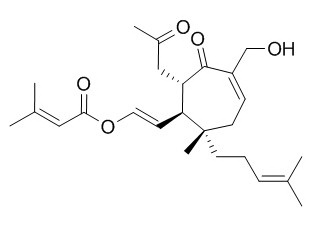Vibsanin C
Standard reference
Inquire / Order:
manager@chemfaces.com
Technical Inquiries:
service@chemfaces.com
Tel:
+86-27-84237783
Fax:
+86-27-84254680
Address:
1 Building, No. 83, CheCheng Rd., Wuhan Economic and Technological Development Zone, Wuhan, Hubei 430056, PRC
Providing storage is as stated on the product vial and the vial is kept tightly sealed, the product can be stored for up to
24 months(2-8C).
Wherever possible, you should prepare and use solutions on the same day. However, if you need to make up stock solutions in advance, we recommend that you store the solution as aliquots in tightly sealed vials at -20C. Generally, these will be useable for up to two weeks. Before use, and prior to opening the vial we recommend that you allow your product to equilibrate to room temperature for at least 1 hour.
Need more advice on solubility, usage and handling? Please email to: service@chemfaces.com
The packaging of the product may have turned upside down during transportation, resulting in the natural compounds adhering to the neck or cap of the vial. take the vial out of its packaging and gently shake to let the compounds fall to the bottom of the vial. for liquid products, centrifuge at 200-500 RPM to gather the liquid at the bottom of the vial. try to avoid loss or contamination during handling.
Int J Mol Sci.2023, 24(8):7442.
Agriculture.2022, 12(3), 342.
Vietnam Journal of Food Control.2022, 5(3):pp.488-497.
Phys Chem Chem Phys.2018, 20(23):15986-15994
Biomed Pharmacother.2023, 163:114785.
Food Chem.2023, 427:136647.
Molecules.2019, 24(2):329
Russian J. Bioorganic Chemistry2024, 50:2897-2903.
Cells.2023, 12(3):395.
Institut Pasteur Korea2020, doi: 10.21203.
Related and Featured Products
Yao Xue Xue Bao. 2013 Mar;48(3):325-32.
Chemistry and biological activities of Viburnum odoratissimum.[Pubmed:
23724642]
METHODS AND RESULTS:
Viburnum odoratissimum is a folk medicinal plant, it can dredge the meridian passage and contains mainly diterpenes, triterpenes, flavonoids, sesquiterpenes, lignans, coumarin glycosides, etc. Vibsanin-type diterpenoids are the characteristic compounds of V. odoratissimum, and are divided into eleven-membered ring, seven-membered ring, and rearrangement-type. Vibsanin B, Vibsanin C and neovibsanin A are the representative compounds of the three subtypes of vibsanin-type diterpenoids respectively.
CONCLUSIONS:
V. odoratissimum has cytotoxic activity, antibacterial activity, fish piscicidal activity and activity of inhibiting the growth of plants, Cytotoxic activity is the main biological activity.
J Nat Prod. 1999 Feb;62(2):337-9.
Chemical conversion of vibsanin C to vibsanin E and structure of 3-hydroxyvibsanin E from viburnum awabuki.[Pubmed:
10075780]
METHODS AND RESULTS:
Vibsanin E (4), a tricyclic vibsane-type diterpene, has been prepared in 50% yield from Vibsanin C (2), a seven-membered ring vibsane-type diterpene by reaction with BF3.OEt2 at -78 degrees C. This chemical correlation not only established structure, including absolute configurations, but also has demonstrated a possible biosynthetic route to 4 via 2 derived from vibsanin B (1).
CONCLUSIONS:
The structure of 3-hydroxyvibsanin E (5), another example of a tricyclic seven-membered ring vibsane, isolated from the leaves of Viburnumawabuki, has been established by extensive analyses of 2D NMR data and comparison of its spectral data with those of 4.
J Nat Prod. 2004 Jan;67(1):74-7.
Vibsane diterpenoids from the leaves and flowers of Viburnum odoratissimum.[Pubmed:
14738390 ]
METHODS AND RESULTS:
In addition to the five known compounds 5-epi-vibsanin H, vibsanins C, H, and G, and aldovibsanin B, four new diterpenes, 5-epi-vibsanin G (1), 18-O-methylvibsanin G (2), vibsanin M (3), and aldoVibsanin C (4), were isolated from an acetone extract of the leaves and flowers of Viburnum odoratissimum by bioassay-directed fractionation. In addition, two acetyl derivatives 5 and 6 were obtained from the naturally occurring diterpenes.
CONCLUSIONS:
The structures of the new compounds were established on the basis of NMR spectral analysis, including COSY, HMQC, HMBC, and NOESY correlations. The compounds were evaluated for cytotoxicity against human nasopharyngeal carcinoma (HONE-1) tumor cells and human gastric cancer (NUGC-3) cells.



